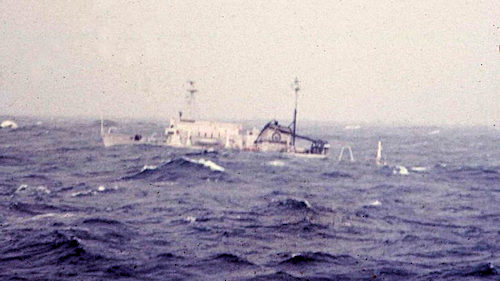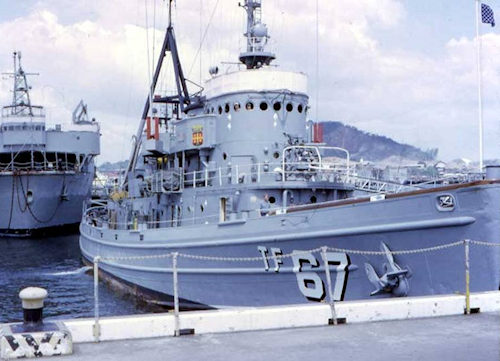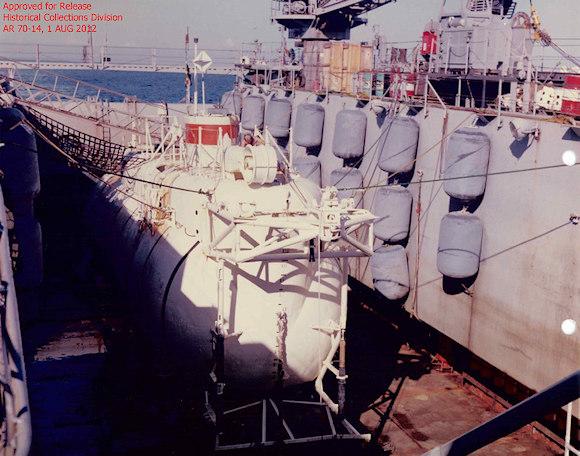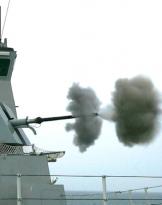(Continued) We then came to the executive phase.
Before the start of the recovery operations, tests were carried out on land and at sea to test the functionality of the bucket and allow the crew members to practice transferring the capsule from the Trieste II (DSV 1) to surface vessels.
An integrated operating unit (IOU), made up of the USS Apache and from the USS White Sands, an auxiliary support vessel for DSV 1, left San Diego for the site chosen for the “sea trials”.
The first tests were disappointing. The DSV 1, almost immediately after the dive, had several problems with sonar, cameras, navigation systems and electrical systems.
On reaching the bottom, the manipulator arm showed considerable difficulty in working on the fake capsule. The biggest problem was the lack of depth perception on the outside of the port, which made it extremely difficult to maneuver the bucket over the target.
During the maneuvers, the winch cable came out of the pulley and broke causing the bucket to fall. Its loss (it weighed about 450 pounds) caused the dive boat to rise uncontrolled about 400 feet before its crew could stop the ascent. It then took 45 minutes to find the bucket on the bottom and the target. Eventually, unable to retrieve both objects with the mechanical arm, the submersible emerged with the bucket brushed down.
After returning to San Diego to refuel and make the necessary modifications, the naval group immediately returned to the sea but, once again, the test was not successful.

This time the submersible was not even able to locate the target on the ocean floor and had a new navigation computer failure, which caused it to emerge about five miles from the destination point.
This delay in readiness began to worry the CIA as the USS de Steiguer (photo) was already passing through the search area. After a third test, although still suffering from problems, it was decided to have the area of operations reached anyway.
In Zone
On October 20, the de Steiguer he communicated that he had identified the capsule on the bottom and that he had photographed it. Once in the area, the USS Apache and White Sands they prepared for the operation.
At 20:30 the White Sands began to flood the internal basin to allow the launching of the DSV 1. An operation that was not easy due to the presence of an annoying long wave. While the USS Apache positioned the underwater transponders (DOT) necessary for the navigation of the bathyscaphe, the White Sands headed to the location where the de Steiguer had placed a transponder to mark the presumed position of the capsule.
One hour and 45 minutes after the dive began, the DSV 1 stopped at a depth approximately 300 feet from the bottom. Although she had discovered several sonar contacts, the submersible could not make any eye contact and feared she was in the wrong position. After numerous attempts the crew decided to end the search and began the ascent.

The next morning, the weather began to deteriorate and did so steadily over the next few days with gusts of wind of 30 knots and swell with waves over three meters high (a rough sea or sea 5). This prevented the recovery of the DSV1 which had to be towed by the USS Apache (Photo) together with the same support vessel.
On November 10, the USS Apache, running out of fuel, was taken over by the USS Current. Due to adverse weather conditions, the USS White Sands and DSV 1 were brought close to the leeward side of the Hawaiian Islands. This allowed the bathyscaphe to finally be recovered and stowed in the floodable basin.
Rear Admiral Paul L. Lacy Jr., commander of the submarine forces of the Pacific Fleet, suggested that the CIA suspend operations until the weather conditions improved but the Agency requested to retry immediately, increasing additional Navy support if necessary. Two tugs were then assigned, theAbnaki and Coucall, for greater flexibility of use in the movements of the vehicles.
On November 24, the naval group returned to the area of operations and the USS Apache he identified all the DOTs which were all still functional. Due to bad weather, the dive was delayed until November 30th.
During the descent, the crew of the DSV 1 (Bartels, Stryker and Taylor) again encountered problems: the sonar failed and, at about 15.000 feet deep, a power failure caused the loss of part of the data on the computer. navigation.

In addition, due to the release of the bucket, the submersible had to proceed leaning on its side. We can imagine the tension of those moments ...
At a certain point the signal from one of the transponders was received which allowed the DSV 1 to orient itself and move towards the presumed position of the capsule.
In the darkness the capsule appeared on the bottom but the boat was too fast and, due to inertia, they went past the target. Back in the vicinity, the low-voltage battery warning light went off. This new failure prevented the installation of a new transponder near the target and, with the little energy remaining (4 battery cells were now exhausted), it was decided to interrupt the mission, and re-emerge.
Due to the constant deterioration of the weather, the operations were again interrupted. Two days later, gusts of thirty knots, with waves of over two meters, almost caused a tragedy. On December 5, the USS White Sands, while towing the DSV 1, he slowed down and stopped. This caused the tow cable to loosen and wrap around the propeller. In an attempt to change the tow cable, a wave tore the submersible which drifted away. The USS Apache managed to retrieve it and tow it, while the USS White Sands, immobilized was at the mercy of the waves. At this point the commander at sea wisely decided to return to Pearl Harbor with the intention of resuming operations after Christmas.
On January 7, 1972, the director of the HEXAGON program, col. Frank S. Buzard, expressed his concern to the NRO leaders, hypothesizing a possible attempt by the Soviet navy to recover the capsule with its precious cargo in case the activity was suspended. However, the operations remained suspended.

On August 16, 1972, the NRO reported that the Soviets not only lacked the ability to retrieve the capsule but there was no evidence that they knew it had crashed. The CIA pointed out that although the Soviet Navy had a spy tug in the Pacific, to monitor the movements of nuclear submarine support ships, on July 10, the day the capsule fell, the intelligence ship was not near the area of the splash down.
Buzard, referring to reports from the Defense Intelligence Agency, one of the many US intelligence agencies, replied that the Soviets could not only be aware of the capsule's fall but could have the ability to retrieve objects at that depth. Furthermore, he added that the rescue operations must have made the Russians suspicious.
The result of this controversy was that five days later the naval group left Pearl Harbor again for the search area. Attempt once again due to adverse weather conditions. The Navy then decided to put the USS White Sands in the basin, postponing operations to the following spring.
As expected by the USN, operations resumed on April 8, and at 17pm on April 00, 25, Bartels, Stryker and Taylor began their new dive. After about 1972 hours, they finally spotted in the darkness a tangled mass of metal and shielded wiring and two jagged pieces of gold foil about seven inches in diameter. Then to follow, about 5 yards away, another component and, finally, the capsule.

After nine minutes of delicate maneuvering and six attempts, the bucket came into position to retrieve the photographic film. The bathyscaphe rose from the bottom, remained motionless for ten minutes to allow the silt and mud to drain, and then, once visibility was restored, began a slow ascent. Ten minutes later the crew noticed that pieces of film began to peel off and get lost in the blue. Almost halfway from the surface, the roller began to break apart into segments of about 80 centimeters.
By the time the DSV 1 arrived close to the surface at around 2:30 am on April 26, that is, more than nine hours after the dive began, there was very little of the precious cargo left. About ten minutes before the divers arrived, the last few meters of film disintegrated under their gaze in a cloud of reddish brown dust leaving only fragments of unusable.
Lessons learned
Photos taken during the operation and post-recovery analysis indicate that the capsule broke on impact and the film partially unwound on the ocean floor as well. Only the top of the capsule appeared to have remained intact.
Despite the many difficulties and the results obtained, the mission was considered a success, thanks above all to the skill of the crew.

From the numerous reports it emerged that many mistakes were made, both in the choice of support means and in the logistic organization, but we must consider that it was the 70s. Locating such a small object at such a depth, in such a remote place and in difficult marine and meteorological conditions was nevertheless a remarkable undertaking. Among the lessons learned, the CIA underlined:
- the need to harmonize operations a priori to avoid carrying out searches in wrong positions. This would have allowed a better use of the DSV 1 from the first dive;
- the operations of the bathyscaphe had been hindered by the meteorological conditions for which it was necessary to study alternative methods of support and recovery of the vessel to operate even in extreme conditions;
- the slowness of movement of the naval group had limited the number of dives in the research area (the ships, moving at about three knots, needed at least three days to transit to the area of operations).
Despite all the operation proved that it was possible to perform the recovery of objects in deep water and the lessons acquired by the USN on the techniques of recovery, detection and underwater navigation, then became international standards in the following years.
A curiosity
Despite the secrecy of the operation, the news leaked in part and the magazine Undersea Technology published a short article on the rescue operation in July 1972, reporting that the Trieste II (DSV-1) had recovered a "Small electronic package" thanks to "Largest operation of its kind ever successfully completed in the world". The release of the article naturally raised a lot of controversy over the leak for obvious security reasons.
Only in 2012 was the secret documentation declassified. The images we have included are part of the original declassified documentation.
Il Trieste II (DSV 1) in 1972 received a commendation of merit for the operation and remained in active service in the Pacific fleet until the early 80s. She was disbarred in 1984 and then transferred to the US Naval Undersea Museum in August 1988 for museum display.
For sea lovers this story can only represent a curiosity, for others it represents a story of life, of men, of challenges at the limit of the possible that only the sea can offer.
Read: "The recovery of the lost spy capsule (part one)"
Photo: CIA / US Navy
(article originally published on https://www.ocean4future.org)












